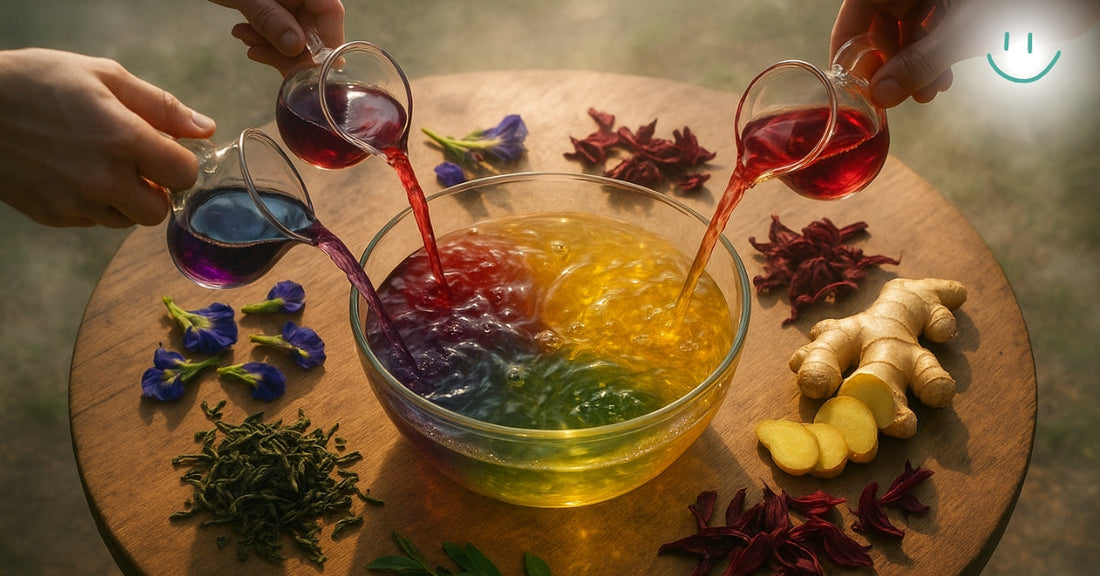
Do Herbs Work Better in Blends? Understanding Herb Synergy, Benefits, and What to Look For
Share
Introduction
If you’ve browsed the wellness aisle or scrolled through herbal tea options online, you’ve probably noticed that many products are “blends”—combinations of several herbs, roots, or flowers in one formula. But do herbs actually work better in blends? And what exactly is “herb synergy”?
Whether you’re looking for a daily tea, an herbal supplement, or just curious about the benefits of combining botanicals, understanding herb synergy can help you make smarter choices for your wellness routine. In this guide, we’ll break down what synergy means, why blends are popular, and how to choose the best combination for your needs.
What Is Herb Synergy?
“Herb synergy” is a term used to describe the special way that herbs can work together—often amplifying each other’s strengths and creating balanced, well-rounded effects. Think of it like a musical band: one instrument can sound great on its own, but when you combine drums, guitar, and vocals, the overall experience is richer and more dynamic.
In traditional medicine systems around the world, blending herbs has been a trusted practice for centuries. Today, modern wellness brands use these same principles to craft blends that support everything from energy and immunity to relaxation and digestion.
How Do Herbs Work Together?
The real magic happens when certain herbs are combined with purpose. Here’s how blends typically work:
- Complementary Effects: One herb may support relaxation while another supports immunity, giving you a broader range of benefits in every cup.
- Balanced Action: Some herbs have strong or stimulating effects that can be balanced out by calming or soothing herbs.
- Flavor and Enjoyment: Let’s not forget taste! A blend can be more enjoyable, making it easier to stick with your wellness ritual.
Examples:
- In a calming tea, you might see chamomile (soothing), lavender (relaxing), and lemon balm (uplifting) all working together.
- An energizing blend might include green tea (gentle caffeine), ginger root (warming, circulation-boosting), and ginseng (adaptogenic support).
Benefits of Herbal Combinations
Why not just stick with single herbs? Here are some of the top herbal combination benefits:
- Wider Range of Support: Blends often target multiple wellness goals at once (think energy and immunity, or skin health and relaxation).
- Gentler, More Balanced Effects: When combined thoughtfully, herbs can create a more balanced effect—reducing the risk of overstimulation or harshness from a single ingredient.
- Convenience: Instead of mixing and matching yourself, you get the right ratio of botanicals in every serving.
- Potential for Enhanced Results: Some herbs actually help each other work better, improving absorption and effectiveness—a phenomenon sometimes supported by research and centuries of traditional use.
Do Herbs Actually Work Better in Blends?
This is the big question! The short answer: Sometimes, yes—but it depends on the blend.
- When Blends Shine: If you want multi-targeted support (like a tea for both relaxation and digestion), blends are ideal. Thoughtfully crafted blends can leverage herb synergy for more holistic results.
- When Single Herbs Are Best: If you have a specific, targeted need (like valerian for sleep, or ginger for nausea), a single-herb approach may be more direct.
- What the Science Says: Research on “herb synergy” is growing, and some studies suggest that multi-herb formulas can have stronger or more consistent effects, especially for things like immune support and stress management. However, quality matters—random mixtures are not always better than the sum of their parts.
What Makes a Good Synergistic Herbal Blend?
With so many options, how can you spot a truly effective blend?
- Ingredient Transparency: Look for blends that list every ingredient and the purpose behind each one—avoid mysterious “proprietary blends.”
- Quality Sourcing: Herbs should be clean, responsibly sourced, and ideally backed by both tradition and modern science.
- Clear Purpose: The blend should have a clear focus—whether it’s energy, calm, immune support, or daily wellness.
- No Fillers or Fluff: Avoid blends overloaded with flavorings, sweeteners, or unnecessary fillers.
- Brand Trust: Choose brands with a commitment to transparency, quality, and customer education—like Wholesome Holistic’s Tea For Life, which is designed for everyday wellness with full ingredient transparency.
Conclusion
Herb synergy is more than just a buzzword—it’s the principle behind centuries of herbal tradition and many of today’s best wellness blends. While single herbs still have their place, synergistic blends can offer broader, more balanced support and make wellness routines simple and enjoyable. Whether you’re new to herbal blends or a long-time fan, understanding how and why blends work will help you get the most from every cup.
Curious to try a blend designed with real synergy? Explore Tea For Life—crafted for holistic, everyday wellness.
